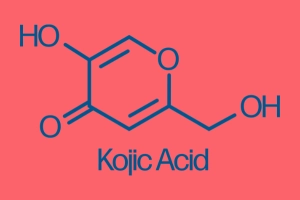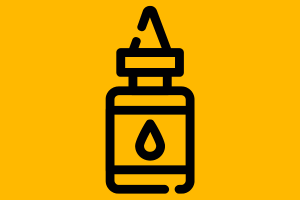Let’s get straight into it…
Structure
Chemical sunscreen
The main ingredients used in chemical sunscreen are all organic. No, not the type of “organic” we talk about when we say “organic vegetables” or “organic produce”.
The primary ingredients in chemical sunscreen are organic compounds, like the ‘organic’ we learned in high school chemistry. Organic compounds contain the element carbon. It’s carbon that differentiates organic compounds from inorganic compounds.
So next time you hear someone say chemical sunscreens are better because they are organic, you can confidently correct them by saying that the ‘organic’ in chemical sunscreen doesn’t necessarily make them better or worse because the organic in chemical sunscreens is a different type of organic than what they are thinking.
Physical sunscreen
Physical sunscreens primarily contain inorganic ingredients. It’s important to note that “inorganic” in this context refers to the same inorganic compounds we learned about in high school chemistry.
Inorganic compounds don’t have carbon in them.
There is a common misconception that physical sunscreens are superior to chemical sunscreens because the latter contains “chemicals”. This belief is based on the false notion that all chemicals harm our skin, which is untrue. In reality, everything is a chemical, including all skincare ingredients. Therefore, the ingredients in a physical sunscreen are also chemicals.
The reason a chemical sunscreen is called a ‘chemical’ sunscreen has nothing to do with its ingredients being chemicals. If so, even physical sunscreens must be called chemical sunscreens because their ingredients are also chemicals. I will explain the reason for the words chemical and physical in their names further down this post.
Common ingredients
Chemical sunscreen
Below are just some of the ingredients used in chemical sunscreens. They are listed in no particular order.
Physical sunscreen
The primary ingredient in every physical sunscreen is one of the following:
Physical sunscreens leave a white cast on our skin. The white cast is due to the zinc oxide and titanium dioxide. The white cast is a property of these two ingredients.
How do they work?
Chemical sunscreen
The ingredients in chemical sunscreen absorb the sun’s UV rays that hit your skin, convert them into harmless forms of energy, mostly heat and then release that energy.
Myth: Chemical sunscreens are harmful because they absorb the sun’s UV rays. Since the sunscreen is on our skin when this absorption happens, the sunscreen can harm our skin.
This is not true. Ignore this myth.
Physical sunscreen
It was previously believed that as soon as the sun’s UV rays hit the physical sunscreen on our skin, the ingredients in the sunscreen make them scatter (go in the other direction so that they don’t touch the skin).
Some believe physical sunscreens must be safer than chemical sunscreens since they don’t absorb but deflect (scatter).
Two points:
First, even if they absorb, chemical sunscreens are no less safe than physical sunscreens.
Second, It has now been proved that physical sunscreens do a bit of both: They absorb and scatter. Let me explain…
The ingredients in physical sunscreen absorb the UV rays that hit our skin, just like the ingredients in a chemical sunscreen. They absorb the UV rays, convert them to heat, and release them. When handling UV rays, both physical and chemical work the same way.
Now, here is where the difference is…A small portion, a very small portion of rays that hit our skin, is visible light. Most chemical sunscreens don’t offer any protection against visible light. With physical sunscreens, when visible light hits our skin, the sunscreen’s ingredients make them scatter.
In summary, most rays that hit our skin are absorbed by the sunscreen, converted into heat, and released by the physical sunscreen ingredients. A small portion of the rays that hit our skin is visible light, which is made to scatter by the physical sunscreen ingredients.
Why are they called ‘chemical’ and ‘physical’?
Physical sunscreens are called such because this sunscreen forms a physical block on the skin, like a shield. Sun’s rays that hit this block get scattered away. Because it blocks by forming a physical layer on the skin, it is called a physical sunscreen.
As mentioned in the earlier section, it was originally believed that physical sunscreens completely block the sun’s rays by physically forming a shield on the skin. But we now know that only a small portion of the rays are blocked; the rest are absorbed. But it’s too late for a name change, I guess. We are still sticking with the original name of these sunscreens: physical sunscreen.
Chemical sunscreens are called such because they don’t form a physical block on the skin. Instead, the ingredients in these sunscreens react with the sun’s rays and absorb them. Since this protection method involves a chemical reaction, it’s called chemical sunscreen.
A quick recap: physical sunscreens also mostly absorb the rays, but this was not known when they were named physical sunscreen.
Do we have to apply sunscreens 15 to 20 minutes before stepping outside?
Chemical sunscreen
Yes.
But why do we have to do this?
Some incorrectly assume this is because the ingredients in chemical sunscreens have to react with the skin first, which takes around 20 minutes, and only after this reaction is completed does the sunscreen become effective. This is untrue.
The real reason is that sunscreen has to form an even film over the skin. Some of the product evaporates when sunscreen is applied, and the rest forms a film. This film needs to dry to be even. This process takes around 20 minutes. Sunscreen protection is even all over only when the film is formed.
Physical sunscreen
Yes.
We must apply 15 to 20 minutes before stepping out for the reasons mentioned in the chemical sunscreen section.
What are mineral sunscreens?
Physical sunscreens are also called mineral sunscreens.
Minerals are naturally occurring elements or compounds. Zinc oxide and titanium dioxide naturally occur. Since these two are the main ingredients in a physical sunscreen, these sunscreens are also called mineral sunscreens.
Water resistance and Sunscreens
Chemical sunscreen
Chemical sunscreens are water resistant and will work even if you are in the water. They are recommended when you are out doing a water activity.
They continue to work even when you are sweating. The water in the sweat will not wear it off.
Of course, you have to reapply the sunscreen every 2 hours. Reapplication is necessary whether you are in or out of the water and wearing a physical or chemical sunscreen.
Physical sunscreen
Physical sunscreens are not water resistant. They don’t work when you are in the water. Sweat also wears it off.
However, some sunscreens combine physical and chemical ingredients. Although these combination sunscreens might contain physical ingredients such as zinc oxide and titanium dioxide, they will work in water.
A thumb role with pure physical sunscreen is that if you can’t see it, it means it’s not working anymore. You need to see that white cast.
UVA protection
Most sunscreens offer UVB protection by default. The level of their UVB protection differs, of course.
What sunscreens can miss out on is offering good UVA protection.
UVA rays penetrate deep into the skin and damage collagen. Collagen damage leads to skin ageing.
UVA penetrates deep. The sun’s UVA rays can penetrate even through glass and reach us indoors.
UVA can cause immediate pigmentation in the skin. When UVA hits unprotected skin, the existing melanin in the skin is distributed, and the melanin is oxidised, causing immediate pigmentation. Meanwhile, the pigmentation from UVB is visible days later. We can minimise the pigmentation effect from UVB by using the right skincare ingredients. However, the pigmentation effect from UVA cannot be minimised unless we use sunscreen, which offers good UVA protection. If you have a darker skin tone (any skin tone other than white), go for the extremely high protection from UVA. I have explained below how to identify UVA protection levels.
A quick note: Both UVA and UVB cause skin cancer.
The level of protection a sunscreen offers against UVA is denoted by one of these two ways:
A broad-spectrum sunscreen offers protection against UVA and UVB. But please don’t stop at the word broad-spectrum on sunscreen; look for the protection level of the UVA, the PA or the PPD rating.
Chemical sunscreen
Avobenzone, a common ingredient, offers good UVA protection. But it degrades quickly. So it has to be reapplied much more frequently than every two hours.
There are a few newer ingredients that offer better protection against UVA. I have listed these below:
Unfortunately, some of these ingredients are not yet approved in some countries. This is in no way an indication of their efficacy. It has more to do with regulatory bodies not keeping up with the latest and being slow in adequately realising the damage UVA can cause.
Physical sunscreen
Zinc oxide provides UVA protection. But its level of protection against UVA is enough. Hence, if you use a pure physical sunscreen, then be aware that it might not be offering the required UVA protection.
Combination sunscreens are a good option – these have ingredients that are both physical and chemical.
What goes first? Order of sunscreen layering?
Skincare products first.
Sunscreen next.
Make-up on top of the sunscreen.
Let me now explain why this order…
To work well, sunscreen needs to be in contact with bare skin.
If you apply makeup on the skin first, the makeup will sit on the skin. Makeup has no penetration capability (it shouldn’t), but it sits as a layer on top of the skin. If you apply sunscreen on top of this makeup, sunscreen cannot come in contact with the skin as makeup sits on the skin as a layer. So, sunscreen becomes ineffective.
If you apply sunscreen first and skincare products on top of it, the skincare will be ineffective. Most sunscreens, especially water-resistant ones, contain occlusive and/or emollient ingredients. These ingredients form a layer on the skin and prevent other ingredients from penetrating it—skincare ingredients to get through to be effective. So, applying skincare on top of the sunscreen keeps sunscreen effective but makes skincare ineffective. So, no point applying skincare on top of sunscreen is a waste.
If you apply skincare first and sunscreen on top of it, the skincare and sunscreen stay effective, provided you don’t use any thick creams as skincare. Then, apply your makeup on top of sunscreen. So, the order is skincare first, sunscreen next, and finally, makeup on top. Some examples of skincare that can work well under sunscreen are a Vitamin C serum, a niacinamide serum, alpha arbutin serum and a light moisturiser. Don’t use any retinol products. If you use niacinamide, ensure sunscreen does not have niacinamide. If sunscreen does have niacinamide, don’t use niacinamide serum.


